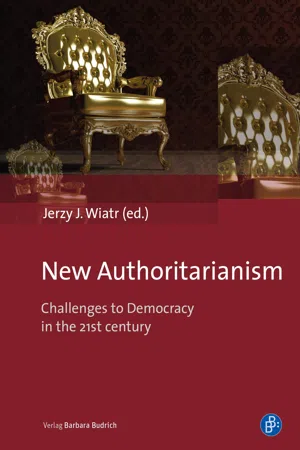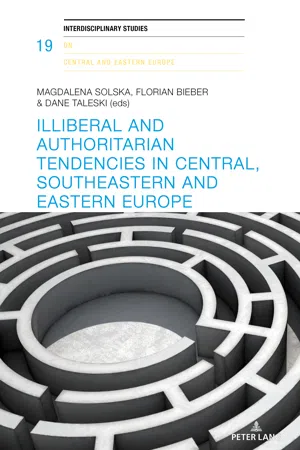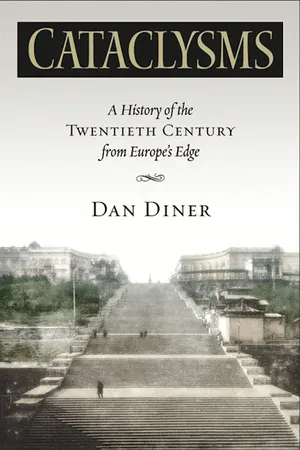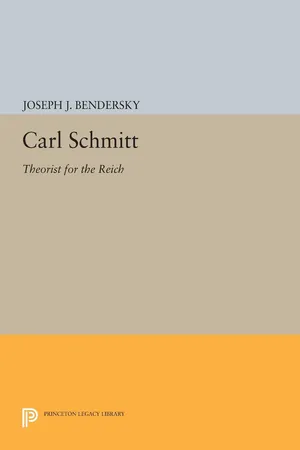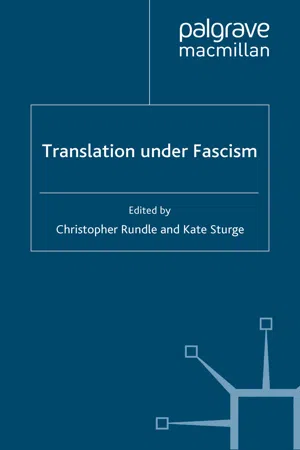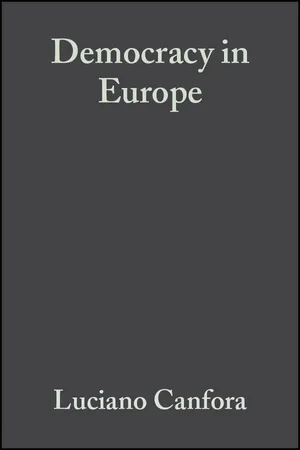History
Democracy and Dictatorship in Germany
"Democracy and Dictatorship in Germany" refers to the historical transition between democratic and dictatorial forms of government in Germany. This transition is marked by the rise of Adolf Hitler and the Nazi regime, which led to the establishment of a dictatorship. The subsequent defeat of Nazi Germany in World War II resulted in the restoration of democracy in the country.
Written by Perlego with AI-assistance
Related key terms
1 of 5
10 Key excerpts on "Democracy and Dictatorship in Germany"
- eBook - PDF
Rethinking the Weimar Republic
Authority and Authoritarianism, 1916-1936
- Anthony McElligott(Author)
- 2013(Publication Date)
- Bloomsbury Academic(Publisher)
8 Authority Between Democracy and Dictatorship “Where is it marching to, the republic? It does not know. [It] Doesn’t even know if it is democratic.” 1 “A bridge leads from democracy to dictatorship, but not from liberalism.” 2 “They’re hopeless Romanticists, living in an unreal past. They’re dreaming of the day when a Kaiser-Messiah will return to place his benevolent (but firm) heel on the necks of the chattering parliamentarians.” 3 Introduction As we have seen in the foregoing chapters, the question of authority underwrote the legitimacy of the Weimar Republic, whether in the spheres of economy, foreign policy, culture and law where it was frequently challenged. This issue of authority was nowhere more visible than in the heavily contested discussions concerning the polity itself. There were, broadly speaking, three interrelated yet competing visions of political authority under the republic: that of democratic authority, authoritarian democracy and dictatorship. Their relationship to one another is the focus of this chapter. After briefly outlining the origins of these ideas in World War I, with particular reference to Hugo Preuß, Max Weber and Carl Schmitt, we move to a discussion of the key provisions relating to the exercise of power and authority in Weimar Constitution. Here, the concept of ‘dictatorship within the bounds of the constitution’ plays a central part in shifting the republic from democratic authority towards authoritarian democracy. The final section of the chapter turns to the popular sphere where developments in ‘high politics’ towards authoritarian government had its counterpart in the mobilization of youth who increasingly sought a ‘strong leader’ or ‘dictator’ as an antidote to the alleged failed politics of the party machine, thus providing the foundations for Hitler’s charismatic dictatorship after 1933. 4 - No longer available |Learn more
Democracy in Modern Europe
A Conceptual History
- Jussi Kurunmäki, Jeppe Nevers, Henk te Velde, Jussi Kurunmäki, Jeppe Nevers, Henk te Velde(Authors)
- 2018(Publication Date)
- Berghahn Books(Publisher)
68As was the case in the United States later on, it was the outbreak of the Second World War that ended these debates and the uncertainties of the public. The British people seemed unbroken by military defeat after defeat even before the United States joined the war. The concerns about whether or not the people would resist the appeal of dictatorship proved to be unfounded. A new idea entered the debate in order to provide a boundary between the ways of political thinking of the major opponents in that war: human rights. If totalitarian regimes could claim any democratic support at all or suggest that they were the more modern way to realize democracy, respect for individual human rights could now be emphazised to be the main distinction between the Western allies and the enemy.Germany in the 1930s: German Exiles and the Concept of Militant Democracy
Even before the Nazis seized power in Germany, a flow of intellectuals had begun to emigrate. After March 1933, German jurists, historians, political thinkers and all kinds of intellectuals travelled to countries in Europe that were still free and later on crossed the Atlantic. Many emigrants provided the remaining democracies with firsthand information and advice on how to respond to fascism. The experiences with the failure of the Weimar Republic were transformed into political theory very differently, in general as well as in terms of democracy. Some intellectuals were motivated to include fascism as part of a broader picture of social development and present civilization. Members of the Frankfurt School, dispersed in different places of exile, drew a very dark picture of the present and the future. Modern civilization turned out not to be the result of progress, but was showing signs of regress into barbarism, of which fascism was only one facet, albeit not the least important one. Fascism could have been judged as a disruption of the irresistible process of civilization or its exception; now it turned out to be the rule and the main direction of history as such.69 - eBook - PDF
Ancient and Modern Democracy
Two Concepts of Liberty?
- Wilfried Nippel, Keith Tribe(Authors)
- 2016(Publication Date)
- Cambridge University Press(Publisher)
18 Ernst Fraenkel, ‘Kollektive Demokratie’ [1929], in his Gesammelte Schriften. Bd. 1: Recht und Politik in der Weimarer Republik, Hubertus Buchstein and Rainer Kühn, eds., Baden-Baden 1999, 343–357, here at 349. As an exile in the United States Fraenkel later published a path- breaking study on the character of the Nazi system: The Dual State. A Contribution to the Theory of Dictatorship, New York 1941. 19 Arthur Rosenberg, Geschichte der Weimarer Republik, Frankfurt am Main 1961, 17f. [first published under the title Geschichte der deutschen Republik, 1935]. 20 Schmitt, Verfassungslehre, 225. Democracy, Führer and Volksgemeinschaft 319 political concepts assumes the most varied, often quite contradictory, meanings, insofar as it is not reduced, in the usual thoughtless way in which common political language is used, to a conventional phrase that no longer has any claim to a particular sense. 21 Kelsen, one of the few committed democrats in the circle of constitutional lawyers, sought a quite formal definition of democracy, characterising an open system as opposed to a closed, autocratic form of government. He argued that the dilemma for democracy was that it could not defend itself if the loyalty of citizens weakened. 22 Back to Arguments from Antiquity In this context the confrontation of ancient and modern democracy, or of ancient and modern liberty, lost force. This does not mean that the contrast did not survive in various sections of specialised academic literature, but its expli- cit use became rarer. One exception in German-language publications during the period after the First World War was an essay published in 1922, ‘Der moderne Freiheitsbegriff und die attische Demokratie’. The author sought to revive the arguments of Constant and Fustel de Coulanges in opposition to the revisions of modern classical scholarship, seeking contradictions in the argu- ments advanced by Wilamowitz, Eduard Meyer and Beloch. - Available until 15 Jan |Learn more
New Authoritarianism
Challenges to Democracy in the 21st century
- Jerzy J. Wiatr(Author)
- 2019(Publication Date)
- Verlag Barbara Budrich(Publisher)
Adam Przeworski A Conceptual History of Political Regimes: Democracy, Dictatorship, and Authoritarianism 1 Introduction Concepts have histories. They appear at specifc times, change meanings at times, disappear sometimes. This has been true of the names of entities we clas- sify as distinct political arrangements. Ancient Greeks saw them as “polities” (politeiai), political philosophers of the modern era thought in terms of “gov- ernments,” behavioral political scientists (Eas- ton 1953) conceptualized them as “political systems,” while the language dominant today conceives them as “political regimes.” Each of these ob- jects, in turn, has been subject to varying distinctions: monarchy, aris- tocracy, and democracy (Aristotle, Polybius); mon- archy, republic, and despotism (Montesquieu); dictatorship and democracy (Lip- set 1959); authoritarianism, totalitarianism, and democracy (Linz 1964, 2000). These distinctions do not travel well in time. To get a sense of the history of the labels used most frequently today, consider the n-gram which portrays the frequency with which the terms “republic,” “democracy”, “dictatorship,” and “authoritarianism” appeared in English language books since 1750. * For comments, I am grateful to Jose Antonio Aguilar Rivera, John Dunn, Joanne Fox-Przewor- ski, Fernando Limongi, Zhaotian Luo, Bernard Manin, Gerry Muncks, Pasquale Pasquino, and Melissa Schwartzberg. 17 The relative frequencies of these concepts does not look very differently in Span- ish or French. In all the three languages, “republic” (sometimes “representative government”) was for a long time a more frequent term than “democracy,” “dic- tatorship” became more frequent only when the word radically changed mean- ing, while “authoritarian- ism” is a recent term. Applying our contemporary distinctions to other periods is thus anachronis- tic. True, one might argue that nothing is wrong with looking at the past through our eyes. - Florian Bieber, Magdalena Solska, Dane Taleski, Nicolas Hayoz, Jens Herlth, Julia Richers(Authors)
- 2019(Publication Date)
- Peter Lang Group(Publisher)
In dictatorships, the society is at the mercy of the state, which aims at ruling and controlling most of the society. Like democracy, dictatorship has several definitions. The minimal- ist, procedural definition describes dictatorship as a regime in which the ruler gains power through means other than competitive elections (Gan- dhi, 2008: 7). The technical nature of this definition reveals little about the nature of dictatorships but helps differentiate them from other regimes. The other approach offers a content-based description, for example, by dis- tinguishing between commissarial (ancient Roman) and sovereign (mod- ern) dictators in which the criteria of sovereignty is the ability to institute and control a state of emergency (Schmitt, 2002). If dictatorship is the opposite of democracy, then the regime from which free elections, the rule of law, civil rights and liberties, and change of government are missing is a dictatorship (Gandhi, 2008: 7). According to the best-known content-based approach, dictatorship has two types: totalitarian and authoritarian. Totalitarian dictatorships expect from their citizenry complete identification with and active support for the regime – being neutral is not tolerated. The mobilizing ideology of these regimes is spread through aggressive propaganda and everyone is required to embrace it. In the totalitarian regimes of Hitler and Stalin, those who did not actively side with the government were automatically considered as enemies of the regime and were marginalized or reckoned with (cf. Arendt, 1951; Friedrich and Brzeziński, 1956; Linz, 2000). Totali- tarian regimes – which rely on their state police rather than the military to control their own citizens through terror – do not only want to eliminate 2 For more about this debate see, for example, Fukuyama (2015) and Levitsky and Way (2015).- eBook - PDF
Weimar
A Jurisprudence of Crisis
- Arthur Jacobson, Bernhard Schlink, Arthur Jacobson, Bernhard Schlink(Authors)
- 2001(Publication Date)
- University of California Press(Publisher)
The fervor of liberal democracy, however, lies at least as much in the demand for guarantees of individual freedom. In the sense of these concepts, German democracy proves to be one of an overwhelmingly liberal stamp, with some concessions to popular referenda in tune with radical democracy. Moreover, the plebiscitary elements of the con-stitutional structure do not so much arise from an ideology or the super-stition that the masses—themselves in part indifferent, in part seducible by demagogues — possess a higher wisdom as from the need for a correc-tive against deformations of parliamentarism and rigidification of the par-ties. And in part they arise from the hope that occasional plebiscites on ma-jor and generally comprehensible questions will have the effect of drawing the people to take a responsible interest in politics. Common to all Ger-man democracy — socialist as well as “bourgeois”— is the conviction that politics and legislation forced on the majority by a minority are not worthy of a free and cultured nation, that such domination by force is unable to solve the great problems of social reform, economic reconstruction, the unity of the Reich, and the unfolding of culture in the sense of a national community, and that it cannot truly become master over the enmity of classes, branches of economic production, confessions, and particularisms. As Friedrich Meinecke shows, . . . it is not so much doctrines that have determined the spirit and details of the German constitution and make it RICHARD THOMA 161 conceivable, as practical reflection on how the task of mastering a particu-lar and almost desperate historical and political situation can be solved. 32 These analyses and intimations only lead through the outer courts to a deepened scholarly insight into the German democracy’s spirit and mode of operation, its social and political preconditions, the dangers of its degen-eration, and the chances of its accomplishment. - eBook - PDF
Cataclysms
A History of the Twentieth Century from Europe’s Edge
- Dan Diner, William Templer, Joel Golb, William Templer, Joel Golb(Authors)
- 2008(Publication Date)
- University of Wisconsin Press(Publisher)
In this way, in its encapsulation of historical experience, the Weimar Republic emerged as a constitu- tive storehouse of memory and experience for the second German republic. It was imperative to learn from Weimar’s mistakes and avoid its aporias. Finally, what happened then was never to hap- pen again. An entire torrent of secondary conclusions has issued from Weimar historiography’s primary political lessons. Real and imag- ined certainties about the past have been reflected in findings en- graved into Germany’s institutional self-awareness. 3 One such certainty about Weimar revolves around the calamities of its democracy—or, more precisely, around the paradigmatic opposi- tion and strict dichotomy manifest in this period between democ- racy and dictatorship. This dichotomy has emerged as a kind of emblem of the interwar years—and this far beyond Germany. It amounts to one of the fundamental insights into the epoch’s expe- rience. If only for the sake of civic education, after World War II a sharp demarcation line between democracy and dictatorship had to be established in Europe’s “post-Fascist” societies, espe- cially West Germany. But in fact, under close scrutiny, insights into both the Nazi dictatorship’s rise and the horrors it perpe- trated that emerge from this conceptual schema hardly prove ad- equate. 4 In this context, in the face of the catastrophe following the erosion of Weimar’s republican and parliamentary options between 1930 and 1933, rather than juxtaposing democracy and dictatorship, it might prove more productive to juxtapose dictator- ship with dictatorship. 5 One advantage of this shift of perspective is its potential for closing a yawning gap in the approaches taken to reconstruct polit- ical causalities: the gap between, on the one hand, the theoretically 108 • - eBook - PDF
Carl Schmitt
Theorist for the Reich
- Joseph W. Bendersky(Author)
- 2014(Publication Date)
- Princeton University Press(Publisher)
And in the elections to the first Reichstag on June 6, 1920, those parties supporting the republic failed to acquire a majority. With voting trends 23 Klemperer, Conservatism, pp. 92-93. EARLY YEARS, 1888-1921 moving to the extreme right and left, the potential for fur- ther disorder still existed. 24 It was during this period of sustained crisis that Schmitt wrote a timely book on a subject that would eventually become closely connected with his name. Die Diktatur (Dic- tatorship), appearing in 1921, was a historical and theo- retical study of the nature of dictatorship from ancient Rome to the Leninist regime. 25 But there was little doubt that contemporary events had prompted Schmitt to undertake this study. For though Die Diktatur was a continuation of his wartime work on the state of exception, Schmitt's view- points had been greatly influenced by the revolutionary postwar situation in Europe. The unexpected Russian and German revolutions had raised questions concerning the legality and legitimacy of a newly created political order, and the current German situation raised the additional problem of how a constitutional system could sustain itself in the face of internal challenges to its authority. In his earlier studies of martial law, Schmitt had already exam- ined the use of dictatorial powers as a means of preserving the existing system. The Leninist dictatorship of the pro- letariat had, however, shown that dictatorship could be revolutionary as well. Schmitt was particularly concerned about the persistent danger from the left, because Bolshe- vism threatened not just the constitution but the German state itself. Moreover, Bolshevism was antithetical to his religion and his entire way of life. And though temporarily suppressed, revolutionary sentiment had by no means been eradicated in Germany. The refusal of the German communists to recognize the 24 Craig, Germany, pp. 429-433. 25 References are to the 1928 edition of Die Diktatur. - eBook - PDF
- C. Rundle, K. Sturge, C. Rundle, K. Sturge(Authors)
- 2010(Publication Date)
- Palgrave Macmillan(Publisher)
The result is an often distort- ing emphasis on control and coercion and a marked reluctance to treat cultural production as anything other than at the service of political 10 The Boundaries of Dictatorship Matthew Philpotts 236 The Boundaries of Dictatorship power, or else heroically raised up against it. For a young researcher seeking to elaborate a comparative cultural history of the GDR and the Third Reich, the methodological impetus signalled by Bessel and Jessen’s programmatic title and, above all, by the insightful essays of Thomas Lindenberger and Mary Fulbrook left a profound impression. Exploring the ‘limits of dictatorship’ became a guiding principle. The significance of these ideas for the study of the cultural history of dictatorships should be clear enough, especially in a comparative volume such as this. There remains an understandable and abiding fas- cination with the highly politicized cultural mechanisms established in dictatorships – typically forms of propaganda and censorship – so that the political boundaries placed on cultural production (another way of understanding the Grenzen der Diktatur) continue to exercise considera- ble influence on the writing of cultural history. One need only think, for example, of the periodization of German culture in the twentieth century to realize how starkly those boundaries can be drawn and how persistent they can be in literary histories and textbooks. It is the political turning points of 1933 and 1945 which usually function as chronological bound- aries between periods. It is political categories – the Weimar Republic, the Third Reich or exile, the GDR or the Federal Republic – which continue to dominate our conceptualizations of German culture in the twentieth century. - eBook - PDF
Democracy in Europe
A History of an Ideoloy
- Luciano Canfora, Simon Jones(Authors)
- 2008(Publication Date)
- Wiley-Blackwell(Publisher)
There was talk of the ‘‘ideas of 1914’’ as against those of 1889. The concept of ‘‘Germanic democracy’’ was a hazy one, essentially centered on the banal idea (distantly related to Tacitus and the ancient German comitatus ) of the ‘‘spontaneous subordination to the leader,’’ obviously now the kaiser. What was pertinent, however, was the criticism by these ideologues of the basis of the ‘‘Western’’ practice of democracy, where they saw all-powerful heavy industry, a subservient press, party systems dominated by a professional and self-referential political ‘‘class,’’ and work-ers’ involvement via unscrupulous trade unionism which had become an integral part of the system, as well as being shamelessly nationalist and imperialist (jingoism). By contrast the (idealized) image of Germanic democ-racy hinged on three elements: the army (which coincided with the people), the bureaucracy, and the sovereign. In January 1918, Wilamowitz wrote: Our army is one and the same as that part of the people that is fit to bear arms, and the unconditional obedience of the soldier arouses, in the free German man, the loyalty typical of the ancient, Germanic spirit of subordina-tion . . . The loyalty of the Prussians to their sovereign is the cornerstone of German power. Our monarchy is the Palladio of our liberty. It is our mon-archy that protects us from tyranny: let anyone who prefers the latter go to America! Under Wilson, they shall find it. But there is also a tyranny of money, of the parliamentary clique, of party politics that is mitigated only by the periodic changes in the individuals who profit by it. 8 The ‘‘classic’’ charge is clearly that parliaments were corrupt in the ‘‘West-ern’’ countries where – precisely – parliamentary systems were unchecked in their relations and intrigues with economic potentates, with no ‘‘external’’ and overriding power (which in ‘‘Germanic democracy’’ would be the kaiser).
Index pages curate the most relevant extracts from our library of academic textbooks. They’ve been created using an in-house natural language model (NLM), each adding context and meaning to key research topics.



